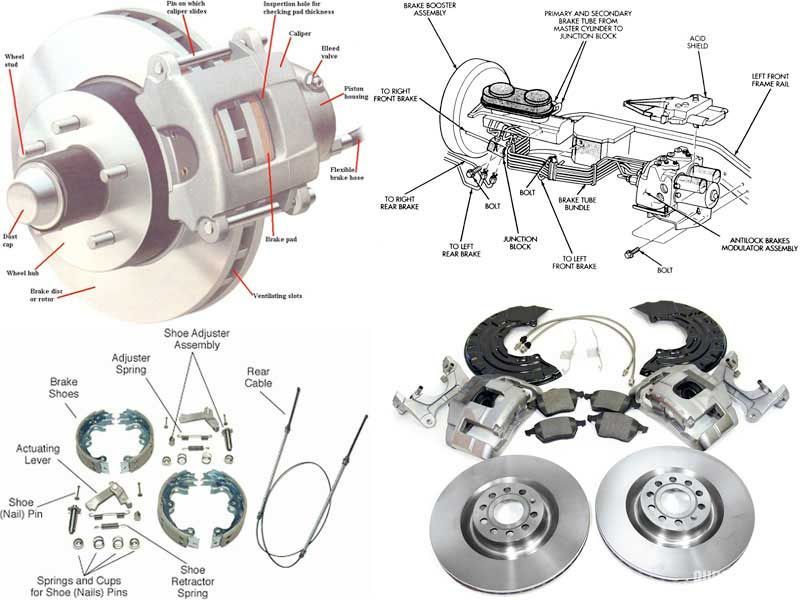Brake System And Components
FEBRUARY 18, 2016

Brake System Components
How does a brake system work?
Your brake system components rely on several, connected parts to function correctly — and safely.
Quick Lesson:
Pressing down the brake pedal activates a cylinder, delivering brake fluid to the calipers. Calipers engage your brake pads, which then apply pressure to the rotors. It is the friction between the brake pads and the rotors that stop your car. See how it’s all connected?
All these different brake parts work together to do one important job: to give you safe and precise stopping power for your ride.
What are brake pads?
Brake pads press on your rotors and this friction slows or stop your car.
What is a rotor?
Each rotor is connected to a tire. When your car is moving, the rotor is spinning. It stops spinning when there is friction from the brake pad.
What is a caliper?
The caliper applies pressure and activates brake pads so the contact the rotors. Brake fluid is required in order for the calipers to function correctly.
What is a brake hose?
Pressing down the brake pedal causes brake fluid to travel through the brake hose to each caliper, which activates the brake pads.
What is brake fluid?
It is a type of hydraulic fluid used in brake systems, enabling the brake pedal to move the brake pads against the rotors, making your car stop. Brake fluid is also a lubricant and anti-corrosion fluid that keeps your brake system working optimally.
You must have brake fluid for your brake system to work properly. It’s a key ingredient. When there is pressure applied to the brake fluid lines, energy is distributed to your brake parts. If your car leaks brake fluid, it could take longer to stop or it may not stop at all. Without any brake fluid, your brakes won’t work, which is a scary situation that no one wants to be in!
What are some common brake fluid problems?
About 20-30 years ago, the most common problem was moisture seeping into the brake fluid, causing corrosion and other issues. But today, moisture in brake fluid isn’t much of an issue because modern brake hoses have innovative designs to reduce moisture intrusion.
Today, brake fluid is accurately tested to determine whether it needs to be replaced. The most common issues stem from dissolved copper levels and depleted additive package. The level of dissolved copper in brake fluid indicates the health of the brake fluid’s additive package. When the additive package is depleted in your brake fluid, the internal brake system components can become corroded and even have sludge build up.
What is brake fluid corrosion?
Brake fluid doesn’t corrode but when the additive package is depleted or breaks down, the brake fluid doesn’t have enough anti-corrosion inhibitors to prevent corrosion of internal hydraulic components.
What is brake fluid additive package?
Brake fluid additive packages are additives, blended into brake fluid by manufacturers. Typical additives include anti-rust and anti-wear chemicals, anti-corrosion inhibitors, acid neutralizing or pH balancers, anti-foaming additives and viscosity stabilizers.
Over time, the additive package blended into brake fluid will become depleted and lose effectiveness. Depletion of additive packages causes many common brake fluid issues, often requiring a brake fluid service in vehicles.
Here are some common causes for the depletion of additive packages:
- Heat or excessive heat from frequent braking
- Overusing brakes while hauling heavy loads
- Stop and go driving
- Low quality additive packages in cheap brake fluids
- Thermal cycling or thermal shock caused by vehicle brakes

Common Brake Fluid Myths
Myth #1: Moisture is the usual problem with old brake fluid.
This was true in the past. Before the application of today’s flexible brake hoses, moisture was a typical problem. It would get into the hoses when the fluid cooled down and cause corrosion. Modern hose manufacturing has eliminated this issue. Thanks to these improvements, the most common issue now is the breakdown of brake fluid additive packages.
Myth #2: Brake fluid never needs to be changed.
Even today’s improved brake fluid requires changing when the copper content get to about 200 PPM (parts per million). Changing the brake fluid renews the additive package and the benefits it offers.
Myth #3: You only have to change the fluid in the master cylinder to ensure fresh fluid in the system.
This will not do. Changing just the fluid in the master cylinder will not provide enough fluid replacement to get the benefits of the correct additive package.
Myth #4: You can’t remove/change over half of the brake fluid in a system, anyway.
At Bullitt Automotive, we can remove the old fluid in the master cylinder, refill it, and then empty the fluid at all four wheels. This process will remove most of the old brake fluid. The new brake fluid is then tested once more, using a test strip, that way we know there is almost no copper remaining in the system.
Myth #5: ABS systems don’t work well after a brake fluid service.
If you have troubles with your ABS system after a break fluid replacement, the fluid might not be flowing smoothly through the HCU (hydraulic control assembly). Using a scan tool, a technician can actuate the HCU valves while flowing clean fluid through the system (performed as specified by the manufacturer).
Myth #6: The same kind of brake fluid can be used in all vehicle types.
Different kinds of vehicles all have different types of brakes — which require different types of fluid. Per the manufacturer’s specifications, our experienced technicians will put the right kind fluid in your car.
Myth #7: Brake systems don’t have copper parts, so how does the brake fluid get dissolved copper?
The lines in your brake system begin as a flat piece of metal that is rolled into a hollow tube and then coated with copper from the inside out. This makes a seamless line. The copper alloy coating is where the copper content of brake fluid comes from. Brake fluid dissolves it from the inside of the brake lines over time.
More information on Brakes:
More Services we offer:
Loading ...
Missing business hours data / Error occurred while getting the data.
Our Location
Have Trouble Finding Us?
Loading ...
Missing nap lines data / Error occured while getting the data.
